Banking and Finance: Share Price Analysis and Royal Commission
VerifiedAdded on 2020/12/24
|13
|3421
|295
Report
AI Summary
This report provides a financial analysis of AMP Limited and Commonwealth Bank of Australia (CBA), examining their share price evolution over five years and the impact of the Royal Commission inquiries on their systematic and unsystematic risks. The report then applies capital budgeting techniques, specifically Net Present Value (NPV) and Internal Rate of Return (IRR), to evaluate the profitability of two hypothetical investment projects. It distinguishes between the required rate of return and IRR, determines the NPV of each project, and discusses the implications of changes in the discount rate. The analysis includes detailed calculations of NPV and IRR for each project, explaining their acceptability and comparing the recommendations that may arise from each method, offering a comprehensive overview of financial analysis and investment decision-making.

BANKING AND FINANCE
Paraphrase This Document
Need a fresh take? Get an instant paraphrase of this document with our AI Paraphraser
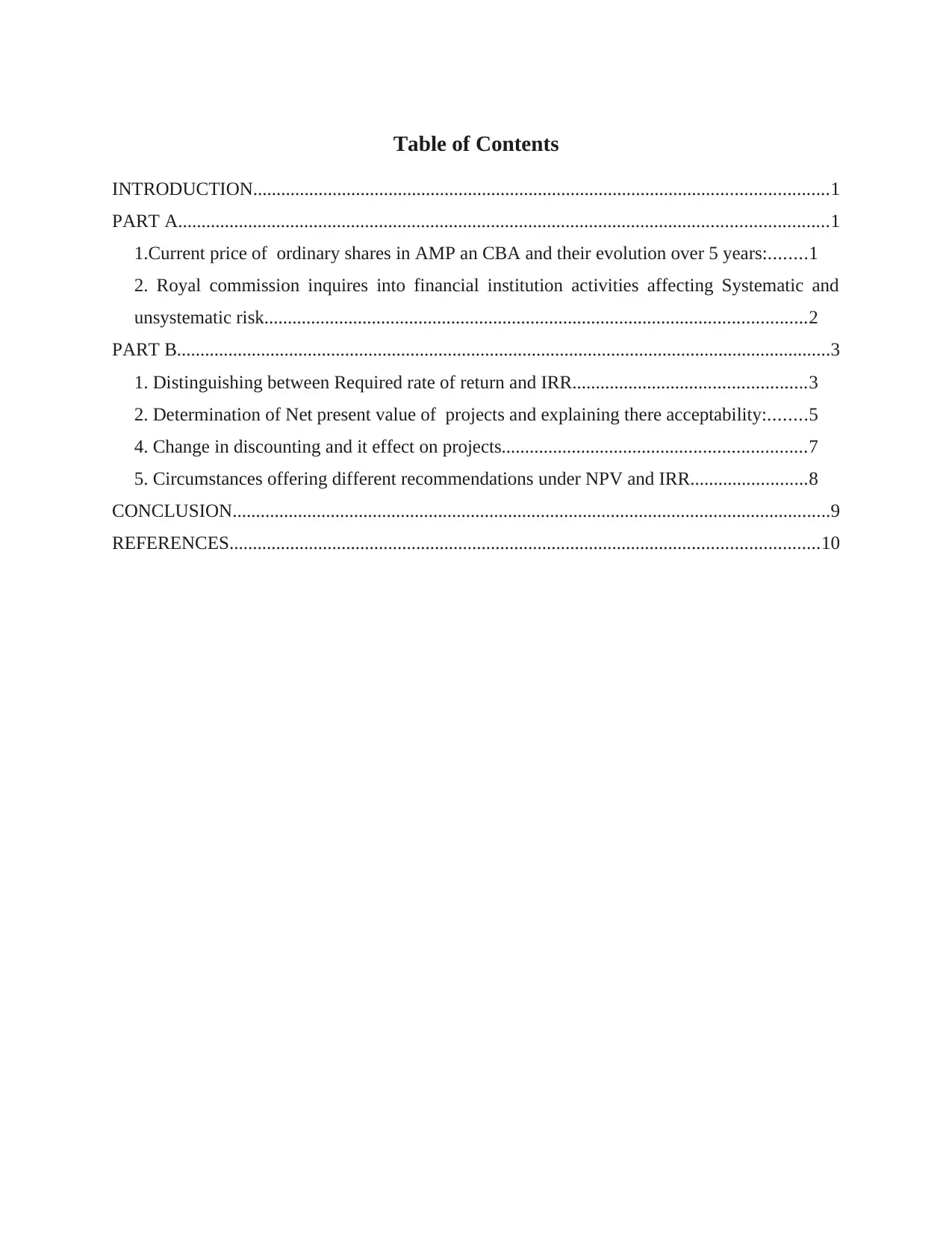
Table of Contents
INTRODUCTION...........................................................................................................................1
PART A...........................................................................................................................................1
1.Current price of ordinary shares in AMP an CBA and their evolution over 5 years:........1
2. Royal commission inquires into financial institution activities affecting Systematic and
unsystematic risk....................................................................................................................2
PART B............................................................................................................................................3
1. Distinguishing between Required rate of return and IRR..................................................3
2. Determination of Net present value of projects and explaining there acceptability:........5
4. Change in discounting and it effect on projects.................................................................7
5. Circumstances offering different recommendations under NPV and IRR.........................8
CONCLUSION................................................................................................................................9
REFERENCES..............................................................................................................................10
INTRODUCTION...........................................................................................................................1
PART A...........................................................................................................................................1
1.Current price of ordinary shares in AMP an CBA and their evolution over 5 years:........1
2. Royal commission inquires into financial institution activities affecting Systematic and
unsystematic risk....................................................................................................................2
PART B............................................................................................................................................3
1. Distinguishing between Required rate of return and IRR..................................................3
2. Determination of Net present value of projects and explaining there acceptability:........5
4. Change in discounting and it effect on projects.................................................................7
5. Circumstances offering different recommendations under NPV and IRR.........................8
CONCLUSION................................................................................................................................9
REFERENCES..............................................................................................................................10
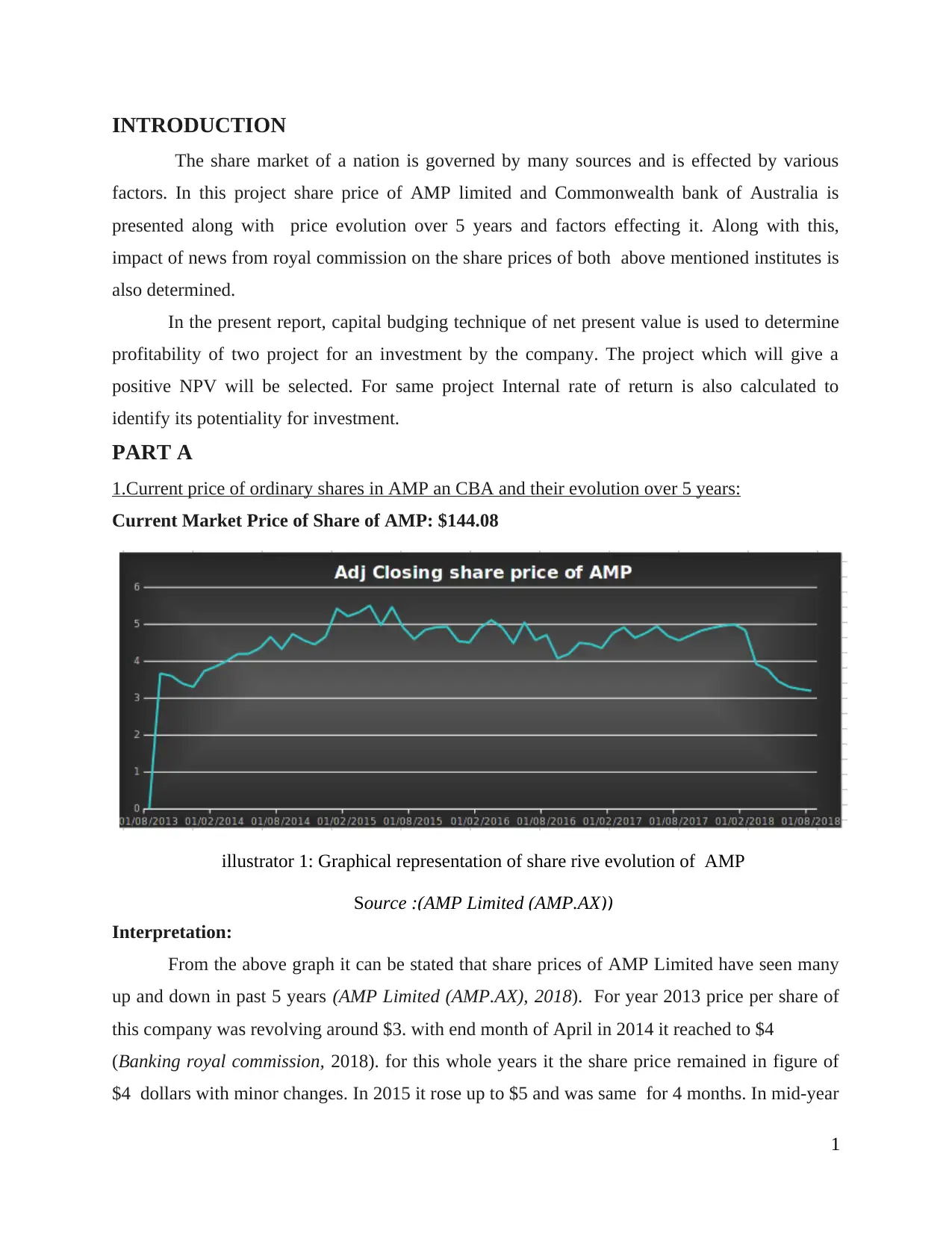
INTRODUCTION
The share market of a nation is governed by many sources and is effected by various
factors. In this project share price of AMP limited and Commonwealth bank of Australia is
presented along with price evolution over 5 years and factors effecting it. Along with this,
impact of news from royal commission on the share prices of both above mentioned institutes is
also determined.
In the present report, capital budging technique of net present value is used to determine
profitability of two project for an investment by the company. The project which will give a
positive NPV will be selected. For same project Internal rate of return is also calculated to
identify its potentiality for investment.
PART A
1.Current price of ordinary shares in AMP an CBA and their evolution over 5 years:
Current Market Price of Share of AMP: $144.08
illustrator 1: Graphical representation of share rive evolution of AMP
Source :(AMP Limited (AMP.AX))
Interpretation:
From the above graph it can be stated that share prices of AMP Limited have seen many
up and down in past 5 years (AMP Limited (AMP.AX), 2018). For year 2013 price per share of
this company was revolving around $3. with end month of April in 2014 it reached to $4
(Banking royal commission, 2018). for this whole years it the share price remained in figure of
$4 dollars with minor changes. In 2015 it rose up to $5 and was same for 4 months. In mid-year
1
The share market of a nation is governed by many sources and is effected by various
factors. In this project share price of AMP limited and Commonwealth bank of Australia is
presented along with price evolution over 5 years and factors effecting it. Along with this,
impact of news from royal commission on the share prices of both above mentioned institutes is
also determined.
In the present report, capital budging technique of net present value is used to determine
profitability of two project for an investment by the company. The project which will give a
positive NPV will be selected. For same project Internal rate of return is also calculated to
identify its potentiality for investment.
PART A
1.Current price of ordinary shares in AMP an CBA and their evolution over 5 years:
Current Market Price of Share of AMP: $144.08
illustrator 1: Graphical representation of share rive evolution of AMP
Source :(AMP Limited (AMP.AX))
Interpretation:
From the above graph it can be stated that share prices of AMP Limited have seen many
up and down in past 5 years (AMP Limited (AMP.AX), 2018). For year 2013 price per share of
this company was revolving around $3. with end month of April in 2014 it reached to $4
(Banking royal commission, 2018). for this whole years it the share price remained in figure of
$4 dollars with minor changes. In 2015 it rose up to $5 and was same for 4 months. In mid-year
1
⊘ This is a preview!⊘
Do you want full access?
Subscribe today to unlock all pages.

Trusted by 1+ million students worldwide
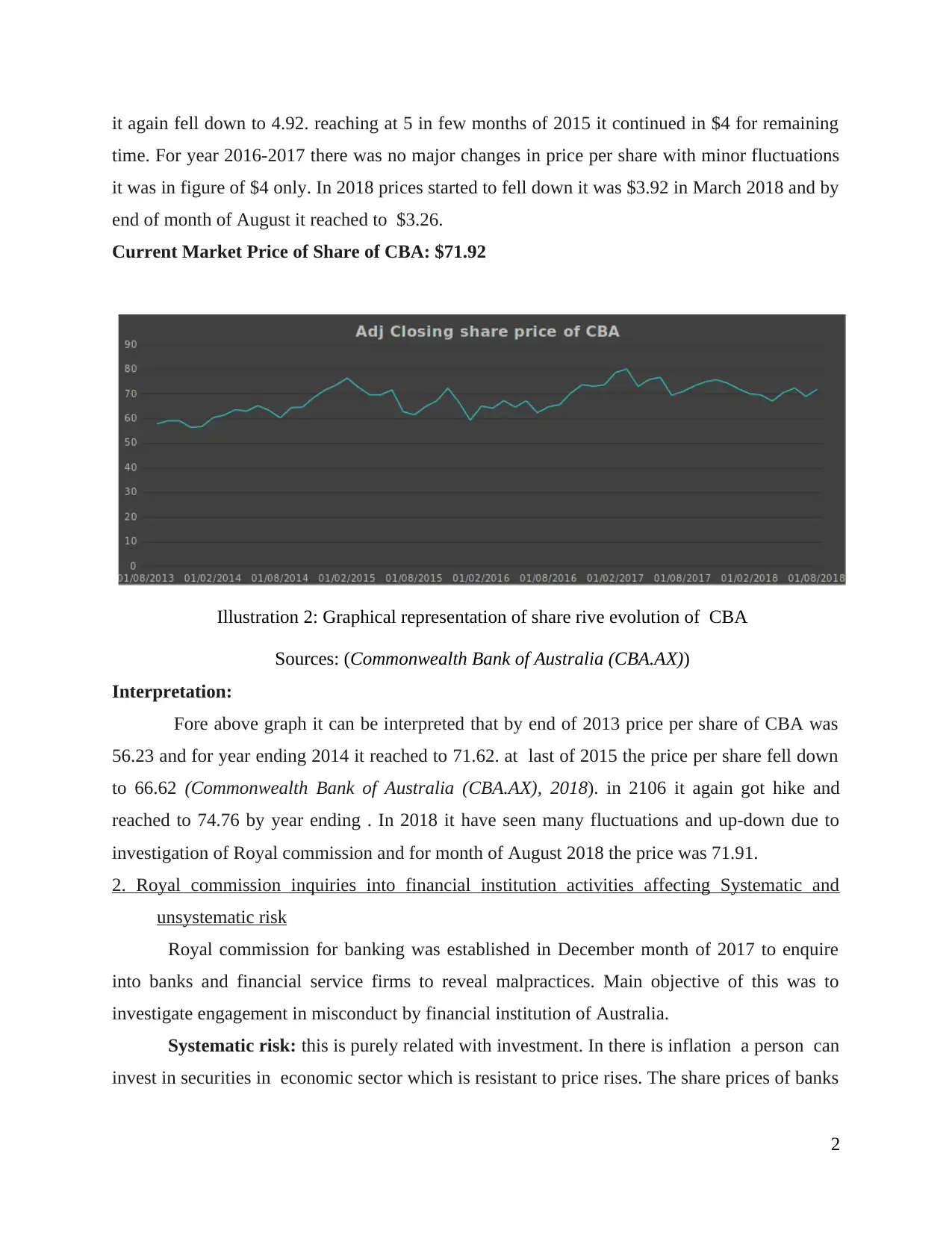
it again fell down to 4.92. reaching at 5 in few months of 2015 it continued in $4 for remaining
time. For year 2016-2017 there was no major changes in price per share with minor fluctuations
it was in figure of $4 only. In 2018 prices started to fell down it was $3.92 in March 2018 and by
end of month of August it reached to $3.26.
Current Market Price of Share of CBA: $71.92
Illustration 2: Graphical representation of share rive evolution of CBA
Sources: (Commonwealth Bank of Australia (CBA.AX))
Interpretation:
Fore above graph it can be interpreted that by end of 2013 price per share of CBA was
56.23 and for year ending 2014 it reached to 71.62. at last of 2015 the price per share fell down
to 66.62 (Commonwealth Bank of Australia (CBA.AX), 2018). in 2106 it again got hike and
reached to 74.76 by year ending . In 2018 it have seen many fluctuations and up-down due to
investigation of Royal commission and for month of August 2018 the price was 71.91.
2. Royal commission inquiries into financial institution activities affecting Systematic and
unsystematic risk
Royal commission for banking was established in December month of 2017 to enquire
into banks and financial service firms to reveal malpractices. Main objective of this was to
investigate engagement in misconduct by financial institution of Australia.
Systematic risk: this is purely related with investment. In there is inflation a person can
invest in securities in economic sector which is resistant to price rises. The share prices of banks
2
time. For year 2016-2017 there was no major changes in price per share with minor fluctuations
it was in figure of $4 only. In 2018 prices started to fell down it was $3.92 in March 2018 and by
end of month of August it reached to $3.26.
Current Market Price of Share of CBA: $71.92
Illustration 2: Graphical representation of share rive evolution of CBA
Sources: (Commonwealth Bank of Australia (CBA.AX))
Interpretation:
Fore above graph it can be interpreted that by end of 2013 price per share of CBA was
56.23 and for year ending 2014 it reached to 71.62. at last of 2015 the price per share fell down
to 66.62 (Commonwealth Bank of Australia (CBA.AX), 2018). in 2106 it again got hike and
reached to 74.76 by year ending . In 2018 it have seen many fluctuations and up-down due to
investigation of Royal commission and for month of August 2018 the price was 71.91.
2. Royal commission inquiries into financial institution activities affecting Systematic and
unsystematic risk
Royal commission for banking was established in December month of 2017 to enquire
into banks and financial service firms to reveal malpractices. Main objective of this was to
investigate engagement in misconduct by financial institution of Australia.
Systematic risk: this is purely related with investment. In there is inflation a person can
invest in securities in economic sector which is resistant to price rises. The share prices of banks
2
Paraphrase This Document
Need a fresh take? Get an instant paraphrase of this document with our AI Paraphraser

which were involved in misconduct have fall down with its detection. These activities and
investigation have made securities market of Australia more vulnerable to sudden fluctuations.
Unsystematic risk: this is related to risk of investment in specific firms. Inquires of royal
commission have impact on share prices of banking and financial institutions (Banking royal
commission, 2018). Last year, CWB was sued by Analysis Centre for $53700 for breach of
money. And its price ealls down by $7 from December 2017 to April 2018.
Impact of news from Royal commission on
AMP Limited:
With investigation of activities of AMP Limited its chief executive admitted that they had
lied to corporate regulators. AMP stated that, they continued to charge life insurance premium
form dead clients superannuation funds even they were notified about death of the person.
The impact of these newses was that it instigated resignation of chief executive of AMP
and he can even face jail. second impact was on its reputation, goodwill and share price. The fall
was sudden but now it is recovering from the effect of news. When it first came down there was
a sudden fall in share prices and with time things have been good and prices are reaching back
to older price without further fall down.
Commonwealth Bank of Australia
With investigation conducted by Royal Commission the CWB accepted the facts that
they were laying to regulators and their financial planners were charging fees to client who have
died. The impact was that it revealed its full year profits of $9.8bn which is up by 4.6%. it was
all found that financial advisory of bank failed to comply with the best interest of consumers
when 75% of files were reviewed (Matthews, 2016). Along with this bank was sued by Analysis
centre (Austrac) for breach of money laundering, bank failed to properly report on $77m of
suspicious transactions through its ATM.
All this resulted in letting down image and reputation of the bank. People started to lose
their faith in authenticity and fair dealing of bank. Impact was so immanence than in period of 5
months its shares prices fell down by $7.
PART B
1. Distinguishing between Required rate of return and IRR
Required rate of return:
3
investigation have made securities market of Australia more vulnerable to sudden fluctuations.
Unsystematic risk: this is related to risk of investment in specific firms. Inquires of royal
commission have impact on share prices of banking and financial institutions (Banking royal
commission, 2018). Last year, CWB was sued by Analysis Centre for $53700 for breach of
money. And its price ealls down by $7 from December 2017 to April 2018.
Impact of news from Royal commission on
AMP Limited:
With investigation of activities of AMP Limited its chief executive admitted that they had
lied to corporate regulators. AMP stated that, they continued to charge life insurance premium
form dead clients superannuation funds even they were notified about death of the person.
The impact of these newses was that it instigated resignation of chief executive of AMP
and he can even face jail. second impact was on its reputation, goodwill and share price. The fall
was sudden but now it is recovering from the effect of news. When it first came down there was
a sudden fall in share prices and with time things have been good and prices are reaching back
to older price without further fall down.
Commonwealth Bank of Australia
With investigation conducted by Royal Commission the CWB accepted the facts that
they were laying to regulators and their financial planners were charging fees to client who have
died. The impact was that it revealed its full year profits of $9.8bn which is up by 4.6%. it was
all found that financial advisory of bank failed to comply with the best interest of consumers
when 75% of files were reviewed (Matthews, 2016). Along with this bank was sued by Analysis
centre (Austrac) for breach of money laundering, bank failed to properly report on $77m of
suspicious transactions through its ATM.
All this resulted in letting down image and reputation of the bank. People started to lose
their faith in authenticity and fair dealing of bank. Impact was so immanence than in period of 5
months its shares prices fell down by $7.
PART B
1. Distinguishing between Required rate of return and IRR
Required rate of return:
3
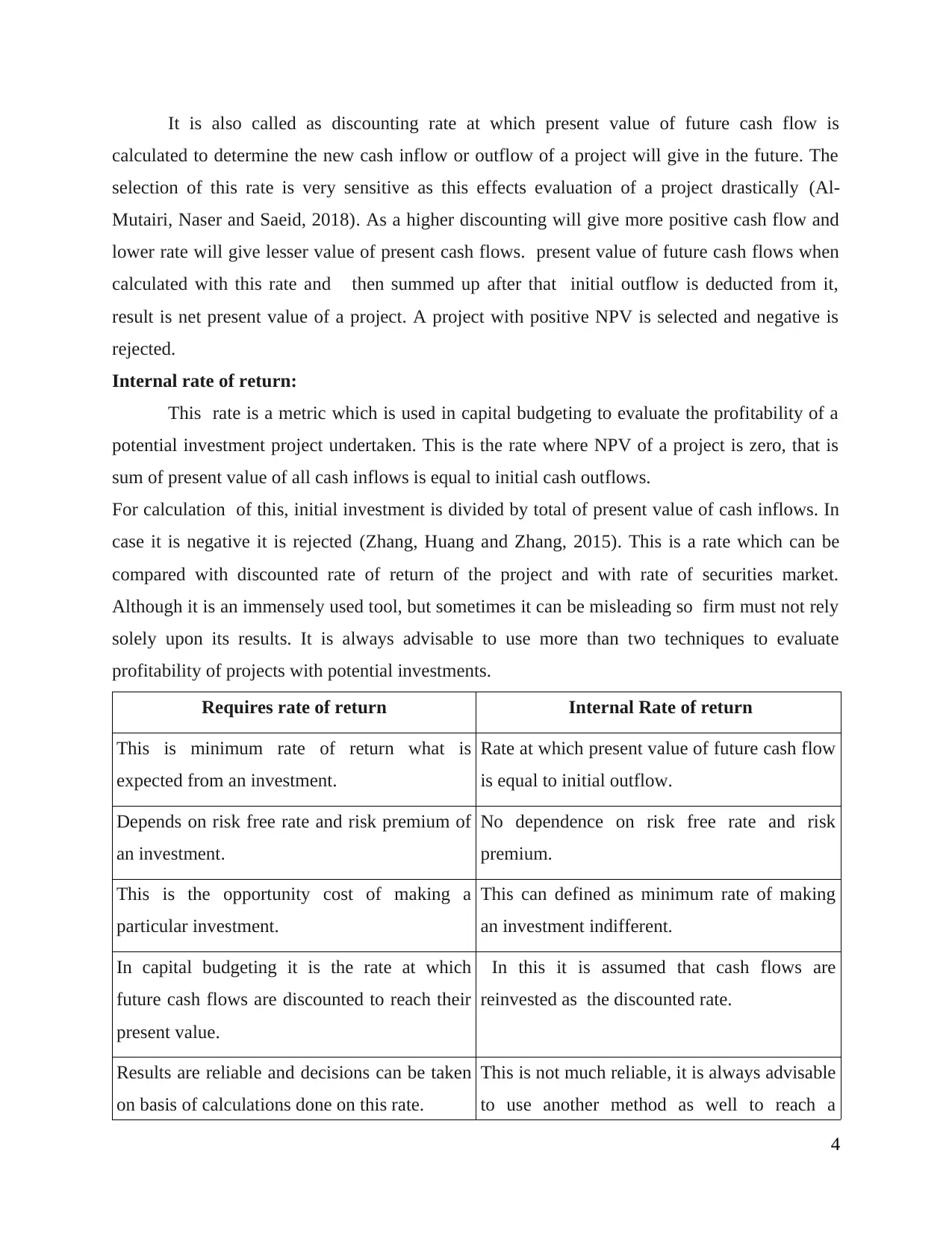
It is also called as discounting rate at which present value of future cash flow is
calculated to determine the new cash inflow or outflow of a project will give in the future. The
selection of this rate is very sensitive as this effects evaluation of a project drastically (Al-
Mutairi, Naser and Saeid, 2018). As a higher discounting will give more positive cash flow and
lower rate will give lesser value of present cash flows. present value of future cash flows when
calculated with this rate and then summed up after that initial outflow is deducted from it,
result is net present value of a project. A project with positive NPV is selected and negative is
rejected.
Internal rate of return:
This rate is a metric which is used in capital budgeting to evaluate the profitability of a
potential investment project undertaken. This is the rate where NPV of a project is zero, that is
sum of present value of all cash inflows is equal to initial cash outflows.
For calculation of this, initial investment is divided by total of present value of cash inflows. In
case it is negative it is rejected (Zhang, Huang and Zhang, 2015). This is a rate which can be
compared with discounted rate of return of the project and with rate of securities market.
Although it is an immensely used tool, but sometimes it can be misleading so firm must not rely
solely upon its results. It is always advisable to use more than two techniques to evaluate
profitability of projects with potential investments.
Requires rate of return Internal Rate of return
This is minimum rate of return what is
expected from an investment.
Rate at which present value of future cash flow
is equal to initial outflow.
Depends on risk free rate and risk premium of
an investment.
No dependence on risk free rate and risk
premium.
This is the opportunity cost of making a
particular investment.
This can defined as minimum rate of making
an investment indifferent.
In capital budgeting it is the rate at which
future cash flows are discounted to reach their
present value.
In this it is assumed that cash flows are
reinvested as the discounted rate.
Results are reliable and decisions can be taken
on basis of calculations done on this rate.
This is not much reliable, it is always advisable
to use another method as well to reach a
4
calculated to determine the new cash inflow or outflow of a project will give in the future. The
selection of this rate is very sensitive as this effects evaluation of a project drastically (Al-
Mutairi, Naser and Saeid, 2018). As a higher discounting will give more positive cash flow and
lower rate will give lesser value of present cash flows. present value of future cash flows when
calculated with this rate and then summed up after that initial outflow is deducted from it,
result is net present value of a project. A project with positive NPV is selected and negative is
rejected.
Internal rate of return:
This rate is a metric which is used in capital budgeting to evaluate the profitability of a
potential investment project undertaken. This is the rate where NPV of a project is zero, that is
sum of present value of all cash inflows is equal to initial cash outflows.
For calculation of this, initial investment is divided by total of present value of cash inflows. In
case it is negative it is rejected (Zhang, Huang and Zhang, 2015). This is a rate which can be
compared with discounted rate of return of the project and with rate of securities market.
Although it is an immensely used tool, but sometimes it can be misleading so firm must not rely
solely upon its results. It is always advisable to use more than two techniques to evaluate
profitability of projects with potential investments.
Requires rate of return Internal Rate of return
This is minimum rate of return what is
expected from an investment.
Rate at which present value of future cash flow
is equal to initial outflow.
Depends on risk free rate and risk premium of
an investment.
No dependence on risk free rate and risk
premium.
This is the opportunity cost of making a
particular investment.
This can defined as minimum rate of making
an investment indifferent.
In capital budgeting it is the rate at which
future cash flows are discounted to reach their
present value.
In this it is assumed that cash flows are
reinvested as the discounted rate.
Results are reliable and decisions can be taken
on basis of calculations done on this rate.
This is not much reliable, it is always advisable
to use another method as well to reach a
4
⊘ This is a preview!⊘
Do you want full access?
Subscribe today to unlock all pages.

Trusted by 1+ million students worldwide
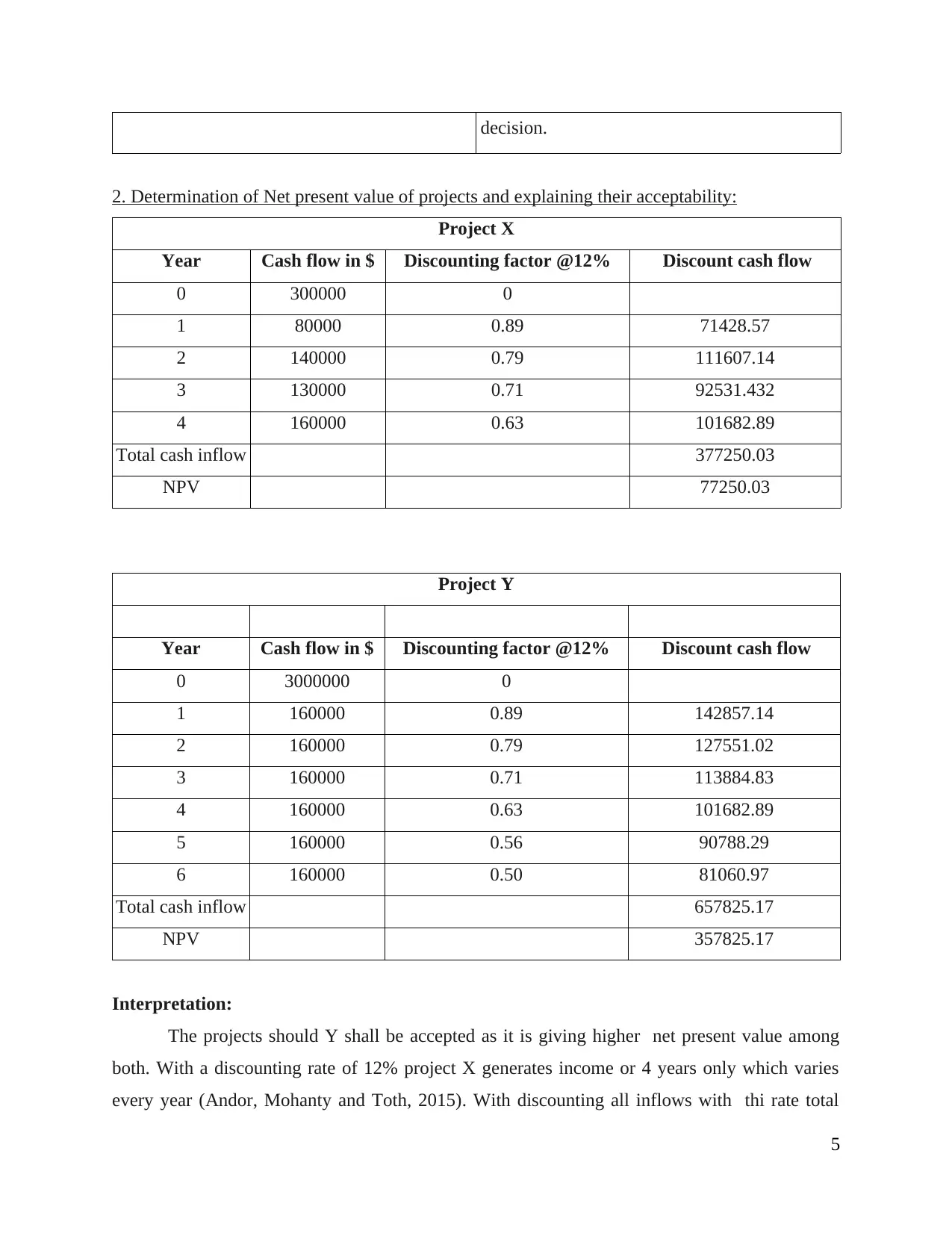
decision.
2. Determination of Net present value of projects and explaining their acceptability:
Project X
Year Cash flow in $ Discounting factor @12% Discount cash flow
0 300000 0
1 80000 0.89 71428.57
2 140000 0.79 111607.14
3 130000 0.71 92531.432
4 160000 0.63 101682.89
Total cash inflow 377250.03
NPV 77250.03
Project Y
Year Cash flow in $ Discounting factor @12% Discount cash flow
0 3000000 0
1 160000 0.89 142857.14
2 160000 0.79 127551.02
3 160000 0.71 113884.83
4 160000 0.63 101682.89
5 160000 0.56 90788.29
6 160000 0.50 81060.97
Total cash inflow 657825.17
NPV 357825.17
Interpretation:
The projects should Y shall be accepted as it is giving higher net present value among
both. With a discounting rate of 12% project X generates income or 4 years only which varies
every year (Andor, Mohanty and Toth, 2015). With discounting all inflows with thi rate total
5
2. Determination of Net present value of projects and explaining their acceptability:
Project X
Year Cash flow in $ Discounting factor @12% Discount cash flow
0 300000 0
1 80000 0.89 71428.57
2 140000 0.79 111607.14
3 130000 0.71 92531.432
4 160000 0.63 101682.89
Total cash inflow 377250.03
NPV 77250.03
Project Y
Year Cash flow in $ Discounting factor @12% Discount cash flow
0 3000000 0
1 160000 0.89 142857.14
2 160000 0.79 127551.02
3 160000 0.71 113884.83
4 160000 0.63 101682.89
5 160000 0.56 90788.29
6 160000 0.50 81060.97
Total cash inflow 657825.17
NPV 357825.17
Interpretation:
The projects should Y shall be accepted as it is giving higher net present value among
both. With a discounting rate of 12% project X generates income or 4 years only which varies
every year (Andor, Mohanty and Toth, 2015). With discounting all inflows with thi rate total
5
Paraphrase This Document
Need a fresh take? Get an instant paraphrase of this document with our AI Paraphraser
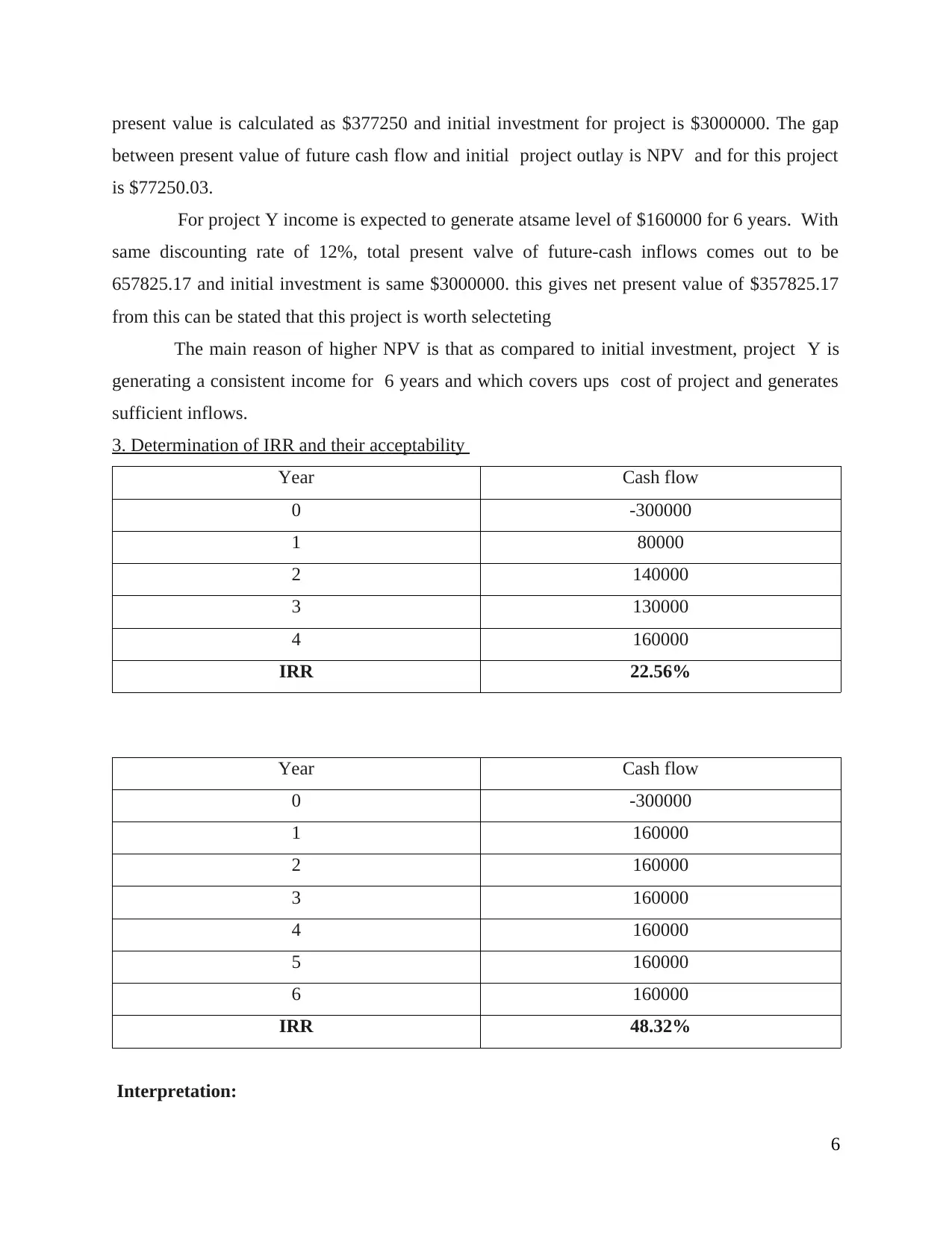
present value is calculated as $377250 and initial investment for project is $3000000. The gap
between present value of future cash flow and initial project outlay is NPV and for this project
is $77250.03.
For project Y income is expected to generate atsame level of $160000 for 6 years. With
same discounting rate of 12%, total present valve of future-cash inflows comes out to be
657825.17 and initial investment is same $3000000. this gives net present value of $357825.17
from this can be stated that this project is worth selecteting
The main reason of higher NPV is that as compared to initial investment, project Y is
generating a consistent income for 6 years and which covers ups cost of project and generates
sufficient inflows.
3. Determination of IRR and their acceptability
Year Cash flow
0 -300000
1 80000
2 140000
3 130000
4 160000
IRR 22.56%
Year Cash flow
0 -300000
1 160000
2 160000
3 160000
4 160000
5 160000
6 160000
IRR 48.32%
Interpretation:
6
between present value of future cash flow and initial project outlay is NPV and for this project
is $77250.03.
For project Y income is expected to generate atsame level of $160000 for 6 years. With
same discounting rate of 12%, total present valve of future-cash inflows comes out to be
657825.17 and initial investment is same $3000000. this gives net present value of $357825.17
from this can be stated that this project is worth selecteting
The main reason of higher NPV is that as compared to initial investment, project Y is
generating a consistent income for 6 years and which covers ups cost of project and generates
sufficient inflows.
3. Determination of IRR and their acceptability
Year Cash flow
0 -300000
1 80000
2 140000
3 130000
4 160000
IRR 22.56%
Year Cash flow
0 -300000
1 160000
2 160000
3 160000
4 160000
5 160000
6 160000
IRR 48.32%
Interpretation:
6

Internal rate of return calculated for project X is 22.56% which means that at this level
the present value of future cash inflows will be same as initial investment of $300000. on
calculating with the IRR present value of upcoming incomes comes out to be 300000.05 which
is same as project investment cost (Beck and Paton, 2018). For Project Y the IRR of return is
calculated as 48.32%, as this rate present value of future cash flows will be equal to initial
investment. On calculating with this rate the total of present amount of inflows is $300023.
The selection of a project on basis of IRR is done on the basis of project which have a
higher rate than rate of cost of capital. In present case both X and Y are giving rates of 22.56%
and 48.32% respectively which is higher than 12%, required rate of return on investment. On
this basis both projects can be selected. But, Project X is more preferable than Y as it IRR is
much lower level at 22.56% as compared to 48.32%. this can be stated that with a lower IRR,
cost of initial investment of $30000 can be covered at a faster pace.
4. Change in discounting and its effect on projects
Project X
Year Cash flow in $ Discounting factor @10% Discount cash flow
0 300000 0
1 80000 0.909 72727.2727272727
2 140000 0.826 115702.479338843
3 130000 0.751 97670.9241172051
4 160000 0.683 109282.152858411
Total cash inflow 395382.829041732
NPV 95382.829041732
Project Y
Year Cash flow in $ Discounting factor @10% Discount cash flow
0 300000 0
1 160000 0.909 145454.54
7
the present value of future cash inflows will be same as initial investment of $300000. on
calculating with the IRR present value of upcoming incomes comes out to be 300000.05 which
is same as project investment cost (Beck and Paton, 2018). For Project Y the IRR of return is
calculated as 48.32%, as this rate present value of future cash flows will be equal to initial
investment. On calculating with this rate the total of present amount of inflows is $300023.
The selection of a project on basis of IRR is done on the basis of project which have a
higher rate than rate of cost of capital. In present case both X and Y are giving rates of 22.56%
and 48.32% respectively which is higher than 12%, required rate of return on investment. On
this basis both projects can be selected. But, Project X is more preferable than Y as it IRR is
much lower level at 22.56% as compared to 48.32%. this can be stated that with a lower IRR,
cost of initial investment of $30000 can be covered at a faster pace.
4. Change in discounting and its effect on projects
Project X
Year Cash flow in $ Discounting factor @10% Discount cash flow
0 300000 0
1 80000 0.909 72727.2727272727
2 140000 0.826 115702.479338843
3 130000 0.751 97670.9241172051
4 160000 0.683 109282.152858411
Total cash inflow 395382.829041732
NPV 95382.829041732
Project Y
Year Cash flow in $ Discounting factor @10% Discount cash flow
0 300000 0
1 160000 0.909 145454.54
7
⊘ This is a preview!⊘
Do you want full access?
Subscribe today to unlock all pages.

Trusted by 1+ million students worldwide
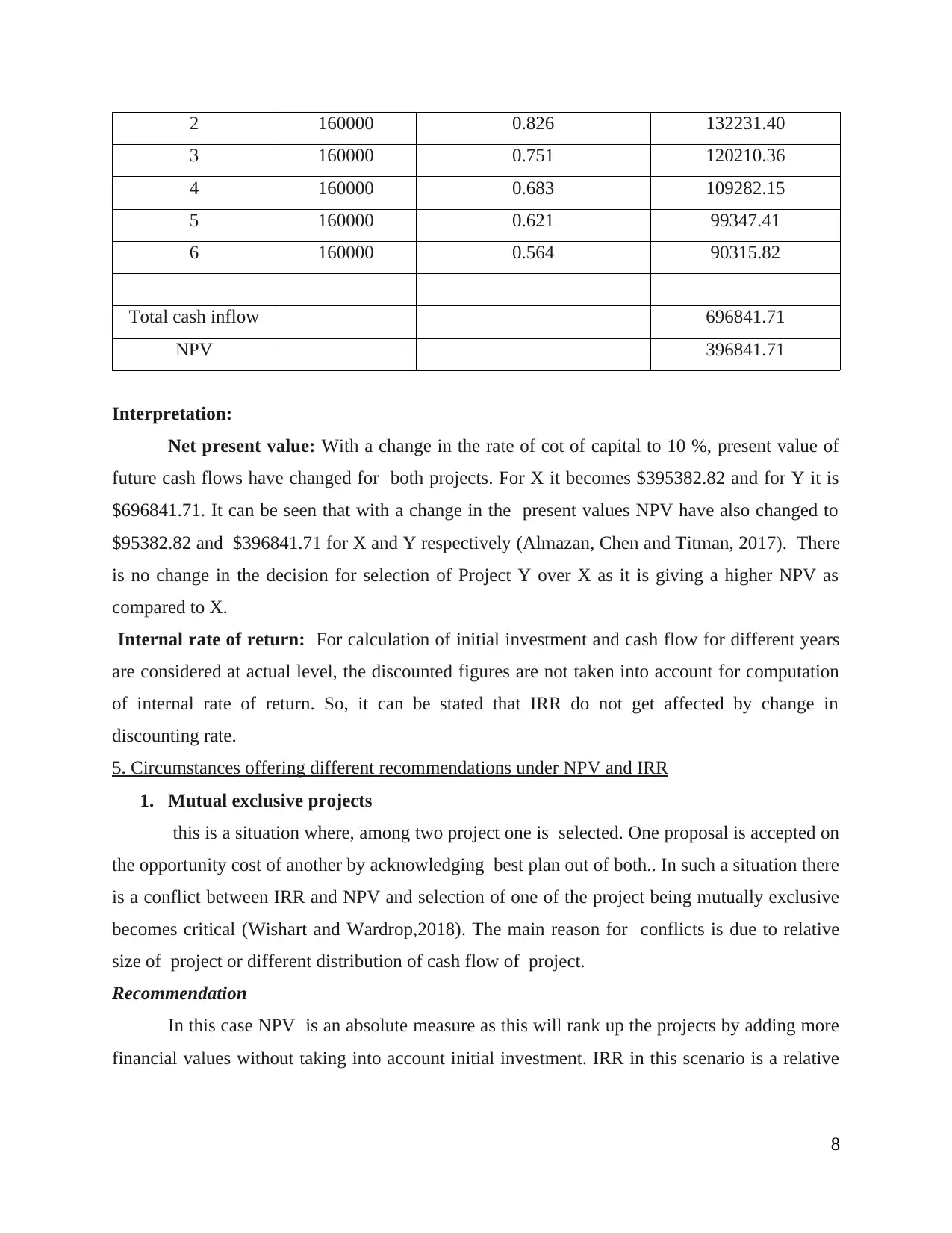
2 160000 0.826 132231.40
3 160000 0.751 120210.36
4 160000 0.683 109282.15
5 160000 0.621 99347.41
6 160000 0.564 90315.82
Total cash inflow 696841.71
NPV 396841.71
Interpretation:
Net present value: With a change in the rate of cot of capital to 10 %, present value of
future cash flows have changed for both projects. For X it becomes $395382.82 and for Y it is
$696841.71. It can be seen that with a change in the present values NPV have also changed to
$95382.82 and $396841.71 for X and Y respectively (Almazan, Chen and Titman, 2017). There
is no change in the decision for selection of Project Y over X as it is giving a higher NPV as
compared to X.
Internal rate of return: For calculation of initial investment and cash flow for different years
are considered at actual level, the discounted figures are not taken into account for computation
of internal rate of return. So, it can be stated that IRR do not get affected by change in
discounting rate.
5. Circumstances offering different recommendations under NPV and IRR
1. Mutual exclusive projects
this is a situation where, among two project one is selected. One proposal is accepted on
the opportunity cost of another by acknowledging best plan out of both.. In such a situation there
is a conflict between IRR and NPV and selection of one of the project being mutually exclusive
becomes critical (Wishart and Wardrop,2018). The main reason for conflicts is due to relative
size of project or different distribution of cash flow of project.
Recommendation
In this case NPV is an absolute measure as this will rank up the projects by adding more
financial values without taking into account initial investment. IRR in this scenario is a relative
8
3 160000 0.751 120210.36
4 160000 0.683 109282.15
5 160000 0.621 99347.41
6 160000 0.564 90315.82
Total cash inflow 696841.71
NPV 396841.71
Interpretation:
Net present value: With a change in the rate of cot of capital to 10 %, present value of
future cash flows have changed for both projects. For X it becomes $395382.82 and for Y it is
$696841.71. It can be seen that with a change in the present values NPV have also changed to
$95382.82 and $396841.71 for X and Y respectively (Almazan, Chen and Titman, 2017). There
is no change in the decision for selection of Project Y over X as it is giving a higher NPV as
compared to X.
Internal rate of return: For calculation of initial investment and cash flow for different years
are considered at actual level, the discounted figures are not taken into account for computation
of internal rate of return. So, it can be stated that IRR do not get affected by change in
discounting rate.
5. Circumstances offering different recommendations under NPV and IRR
1. Mutual exclusive projects
this is a situation where, among two project one is selected. One proposal is accepted on
the opportunity cost of another by acknowledging best plan out of both.. In such a situation there
is a conflict between IRR and NPV and selection of one of the project being mutually exclusive
becomes critical (Wishart and Wardrop,2018). The main reason for conflicts is due to relative
size of project or different distribution of cash flow of project.
Recommendation
In this case NPV is an absolute measure as this will rank up the projects by adding more
financial values without taking into account initial investment. IRR in this scenario is a relative
8
Paraphrase This Document
Need a fresh take? Get an instant paraphrase of this document with our AI Paraphraser
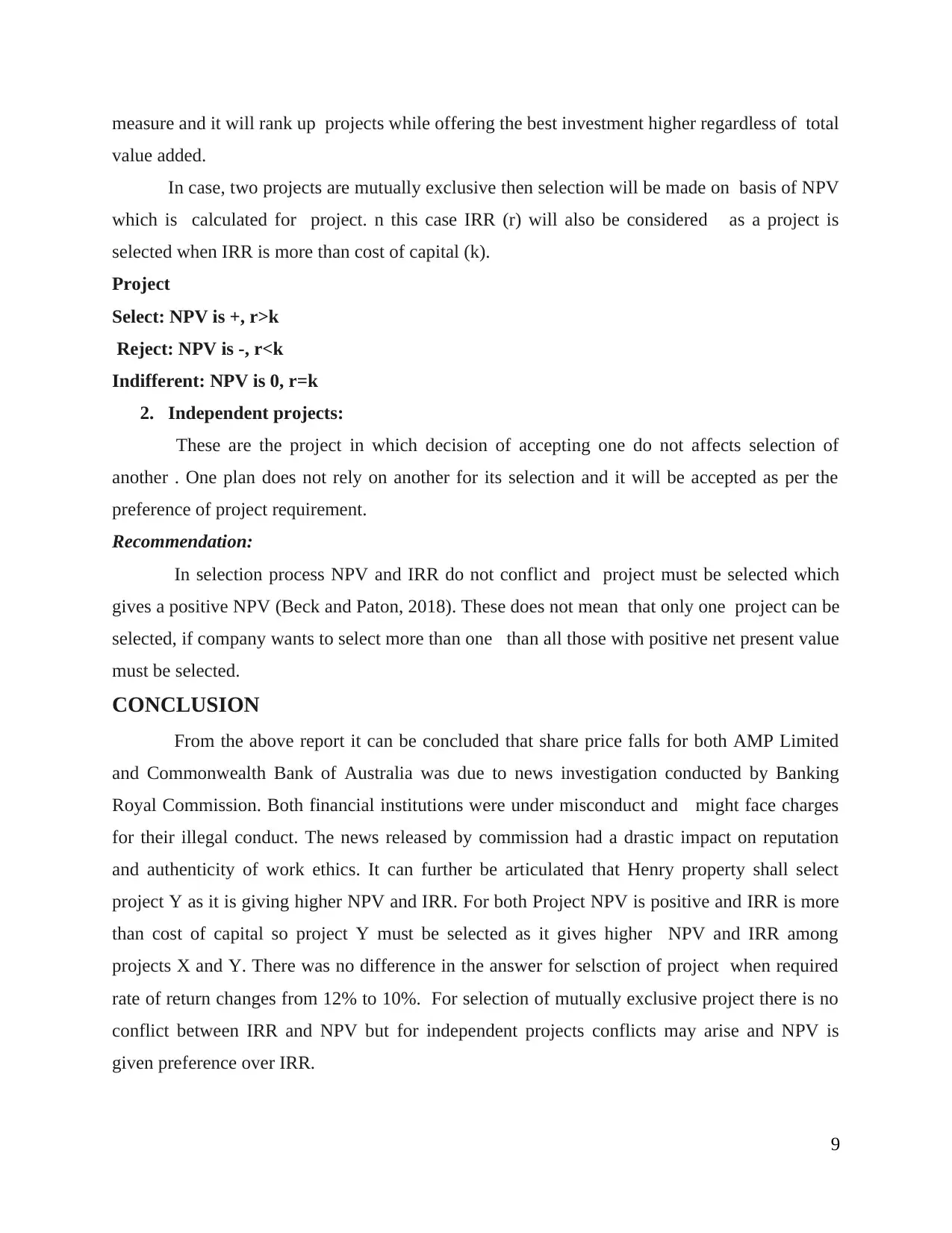
measure and it will rank up projects while offering the best investment higher regardless of total
value added.
In case, two projects are mutually exclusive then selection will be made on basis of NPV
which is calculated for project. n this case IRR (r) will also be considered as a project is
selected when IRR is more than cost of capital (k).
Project
Select: NPV is +, r>k
Reject: NPV is -, r<k
Indifferent: NPV is 0, r=k
2. Independent projects:
These are the project in which decision of accepting one do not affects selection of
another . One plan does not rely on another for its selection and it will be accepted as per the
preference of project requirement.
Recommendation:
In selection process NPV and IRR do not conflict and project must be selected which
gives a positive NPV (Beck and Paton, 2018). These does not mean that only one project can be
selected, if company wants to select more than one than all those with positive net present value
must be selected.
CONCLUSION
From the above report it can be concluded that share price falls for both AMP Limited
and Commonwealth Bank of Australia was due to news investigation conducted by Banking
Royal Commission. Both financial institutions were under misconduct and might face charges
for their illegal conduct. The news released by commission had a drastic impact on reputation
and authenticity of work ethics. It can further be articulated that Henry property shall select
project Y as it is giving higher NPV and IRR. For both Project NPV is positive and IRR is more
than cost of capital so project Y must be selected as it gives higher NPV and IRR among
projects X and Y. There was no difference in the answer for selsction of project when required
rate of return changes from 12% to 10%. For selection of mutually exclusive project there is no
conflict between IRR and NPV but for independent projects conflicts may arise and NPV is
given preference over IRR.
9
value added.
In case, two projects are mutually exclusive then selection will be made on basis of NPV
which is calculated for project. n this case IRR (r) will also be considered as a project is
selected when IRR is more than cost of capital (k).
Project
Select: NPV is +, r>k
Reject: NPV is -, r<k
Indifferent: NPV is 0, r=k
2. Independent projects:
These are the project in which decision of accepting one do not affects selection of
another . One plan does not rely on another for its selection and it will be accepted as per the
preference of project requirement.
Recommendation:
In selection process NPV and IRR do not conflict and project must be selected which
gives a positive NPV (Beck and Paton, 2018). These does not mean that only one project can be
selected, if company wants to select more than one than all those with positive net present value
must be selected.
CONCLUSION
From the above report it can be concluded that share price falls for both AMP Limited
and Commonwealth Bank of Australia was due to news investigation conducted by Banking
Royal Commission. Both financial institutions were under misconduct and might face charges
for their illegal conduct. The news released by commission had a drastic impact on reputation
and authenticity of work ethics. It can further be articulated that Henry property shall select
project Y as it is giving higher NPV and IRR. For both Project NPV is positive and IRR is more
than cost of capital so project Y must be selected as it gives higher NPV and IRR among
projects X and Y. There was no difference in the answer for selsction of project when required
rate of return changes from 12% to 10%. For selection of mutually exclusive project there is no
conflict between IRR and NPV but for independent projects conflicts may arise and NPV is
given preference over IRR.
9
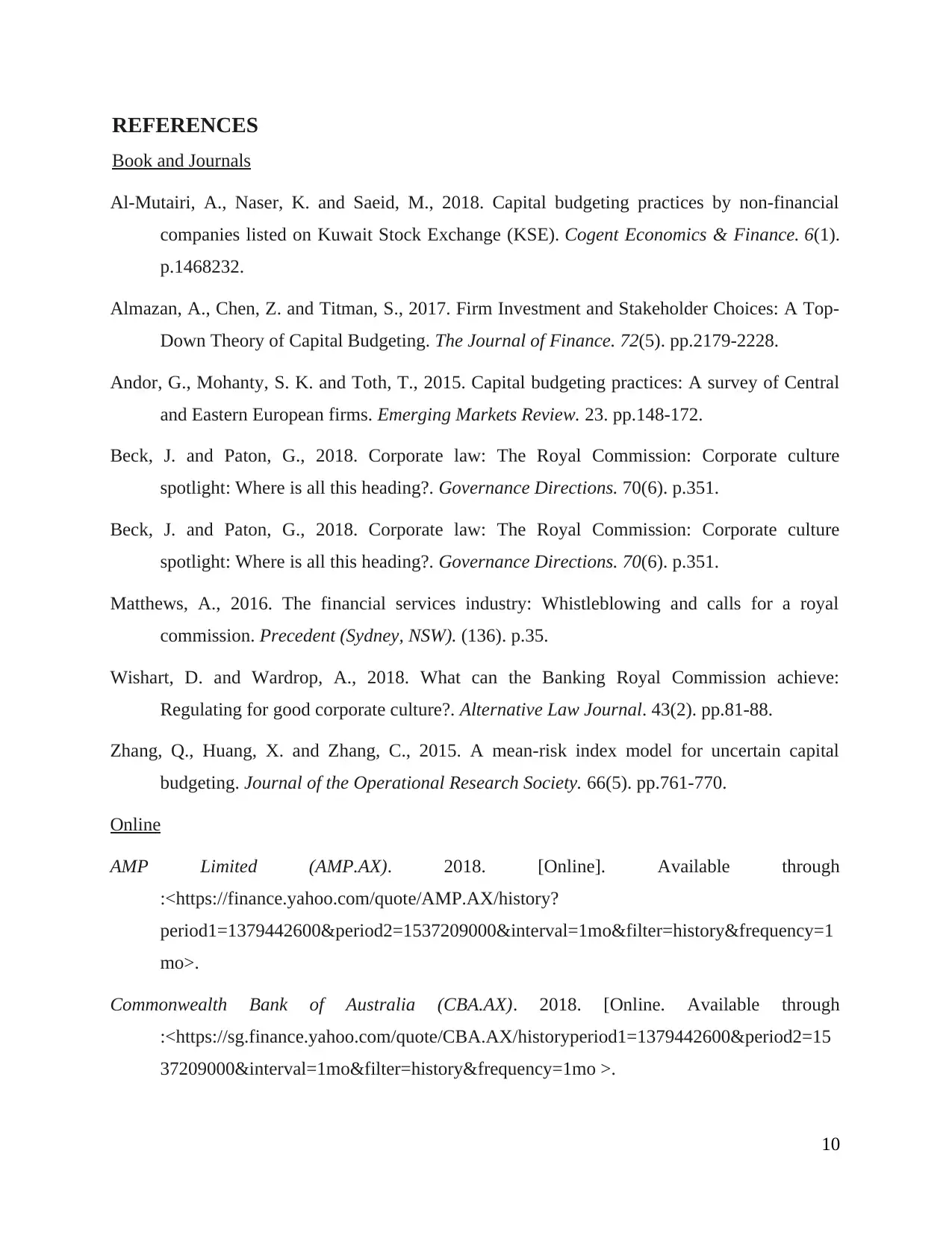
REFERENCES
Book and Journals
Al-Mutairi, A., Naser, K. and Saeid, M., 2018. Capital budgeting practices by non-financial
companies listed on Kuwait Stock Exchange (KSE). Cogent Economics & Finance. 6(1).
p.1468232.
Almazan, A., Chen, Z. and Titman, S., 2017. Firm Investment and Stakeholder Choices: A Top‐
Down Theory of Capital Budgeting. The Journal of Finance. 72(5). pp.2179-2228.
Andor, G., Mohanty, S. K. and Toth, T., 2015. Capital budgeting practices: A survey of Central
and Eastern European firms. Emerging Markets Review. 23. pp.148-172.
Beck, J. and Paton, G., 2018. Corporate law: The Royal Commission: Corporate culture
spotlight: Where is all this heading?. Governance Directions. 70(6). p.351.
Beck, J. and Paton, G., 2018. Corporate law: The Royal Commission: Corporate culture
spotlight: Where is all this heading?. Governance Directions. 70(6). p.351.
Matthews, A., 2016. The financial services industry: Whistleblowing and calls for a royal
commission. Precedent (Sydney, NSW). (136). p.35.
Wishart, D. and Wardrop, A., 2018. What can the Banking Royal Commission achieve:
Regulating for good corporate culture?. Alternative Law Journal. 43(2). pp.81-88.
Zhang, Q., Huang, X. and Zhang, C., 2015. A mean-risk index model for uncertain capital
budgeting. Journal of the Operational Research Society. 66(5). pp.761-770.
Online
AMP Limited (AMP.AX). 2018. [Online]. Available through
:<https://finance.yahoo.com/quote/AMP.AX/history?
period1=1379442600&period2=1537209000&interval=1mo&filter=history&frequency=1
mo>.
Commonwealth Bank of Australia (CBA.AX). 2018. [Online. Available through
:<https://sg.finance.yahoo.com/quote/CBA.AX/historyperiod1=1379442600&period2=15
37209000&interval=1mo&filter=history&frequency=1mo >.
10
Book and Journals
Al-Mutairi, A., Naser, K. and Saeid, M., 2018. Capital budgeting practices by non-financial
companies listed on Kuwait Stock Exchange (KSE). Cogent Economics & Finance. 6(1).
p.1468232.
Almazan, A., Chen, Z. and Titman, S., 2017. Firm Investment and Stakeholder Choices: A Top‐
Down Theory of Capital Budgeting. The Journal of Finance. 72(5). pp.2179-2228.
Andor, G., Mohanty, S. K. and Toth, T., 2015. Capital budgeting practices: A survey of Central
and Eastern European firms. Emerging Markets Review. 23. pp.148-172.
Beck, J. and Paton, G., 2018. Corporate law: The Royal Commission: Corporate culture
spotlight: Where is all this heading?. Governance Directions. 70(6). p.351.
Beck, J. and Paton, G., 2018. Corporate law: The Royal Commission: Corporate culture
spotlight: Where is all this heading?. Governance Directions. 70(6). p.351.
Matthews, A., 2016. The financial services industry: Whistleblowing and calls for a royal
commission. Precedent (Sydney, NSW). (136). p.35.
Wishart, D. and Wardrop, A., 2018. What can the Banking Royal Commission achieve:
Regulating for good corporate culture?. Alternative Law Journal. 43(2). pp.81-88.
Zhang, Q., Huang, X. and Zhang, C., 2015. A mean-risk index model for uncertain capital
budgeting. Journal of the Operational Research Society. 66(5). pp.761-770.
Online
AMP Limited (AMP.AX). 2018. [Online]. Available through
:<https://finance.yahoo.com/quote/AMP.AX/history?
period1=1379442600&period2=1537209000&interval=1mo&filter=history&frequency=1
mo>.
Commonwealth Bank of Australia (CBA.AX). 2018. [Online. Available through
:<https://sg.finance.yahoo.com/quote/CBA.AX/historyperiod1=1379442600&period2=15
37209000&interval=1mo&filter=history&frequency=1mo >.
10
⊘ This is a preview!⊘
Do you want full access?
Subscribe today to unlock all pages.

Trusted by 1+ million students worldwide

Banking royal commission. 2018. [Online]. Available through
:<https://www.theguardian.com/australia-news/2018/apr/20/banking-royal-commission-
all-you-need-to-know-so-far>.
11
:<https://www.theguardian.com/australia-news/2018/apr/20/banking-royal-commission-
all-you-need-to-know-so-far>.
11
1 out of 13
Related Documents
Your All-in-One AI-Powered Toolkit for Academic Success.
+13062052269
info@desklib.com
Available 24*7 on WhatsApp / Email
![[object Object]](/_next/static/media/star-bottom.7253800d.svg)
Unlock your academic potential
© 2024 | Zucol Services PVT LTD | All rights reserved.





